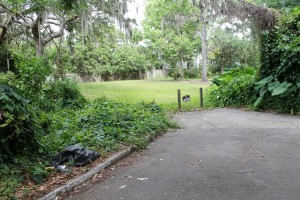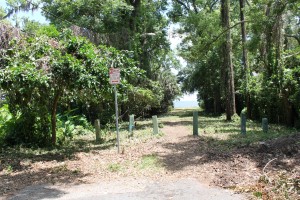Residents circle wagons to prevent river access closure
Posted on June 4, 2015 By Editor Articles, Neighborhood News, Top Stories
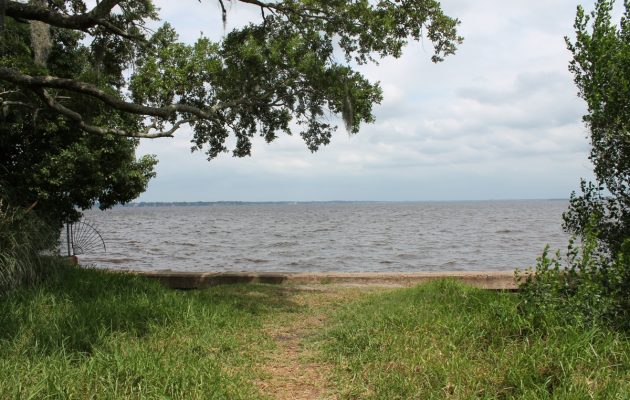
Motives for bill’s fast track not clear, questioned by residents
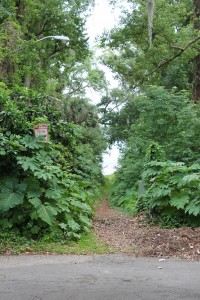
Restricted parking sign at entrance to river access partially hidden by overgrowth before residents cleaned it up last month.
The path from Richmond Street along Little Van Wert down to the St. Johns River was, until recently, overgrown but visitors still traverse it to the sea wall, where it is a great vantage point for fishing, watching fireworks and the Blue Angels, as well as for a few moments of peace and solitude.
But if John and Kristen Surface and Charles and Joan Cousar – neighbors on either side of the path – have their way, a fast-tracked bill [2015-360] will close the public right-of-way access to the river.
The bill was introduced to City Council on May 12 by District 3 Councilman Richard Clark and residents are wondering why Clark, who represents East Arlington neighborhoods between I-295 and the Intercoastal Waterway, would be interested in an Avondale river access point in District 14.
The Resident reached out to Clark, via phone and email, with the same question, but had not received a response as of press time.
The first public hearing was held on May 26 at City Council and nearly three dozen people spoke during the public comment session, at a ratio of about 2:1 against the bill.
Unless the fast-tracked bill can be delayed for two weeks, it is on the agendas to be addressed by both the Rules and the Transportation, Energy, Utility (TEU) committees on June 1, and the Recreation, Community Development, Public Health & Safety (RCDPHS) and Land Use and Zoning (LUZ) committees on June 2, with a Council vote expected on June 9.
Clark’s bill also proposes to waive the requirement for Public Works to perform an administrative review and receive favorable replies from all agencies prior to legislation for closure being submitted to Council. Additionally, the bill would “allow the right-of-way to revert to the property owners on either side of the property.”
According to casual estimates cited by other property owners in the neighborhood, that access could be worth $600,000 to $700,000. If it were to revert to either or both adjoining property owners, they will have obtained it for the cost of the $1,688 application fee plus attorney’s fees.
Public notice sets off alarms
When Don Rushlow, who lives on Hedrick Street one block from the access, saw the public notice posted at the entrance to the access point last month after the bill was introduced at the May 12 Council meeting, he immediately began a door-to-door campaign to alert surrounding homeowners.
“For some unknown reason, the city stopped mowing and maintaining this access a few years back. There is still a clear path you walk to get down to the Sea Wall,” he noted in his appeal to neighbors. “Because of the city’s neglect, there is a lot of vegetation overgrowth on either side of the path and poor lighting at night. Now the city is going to abandon it entirely.”
Rushlow also contacted media outlets, Riverside Avondale Preservation (RAP) and District 14 Councilman Jim Love, as well as Councilman Clark. RAP responded with a statement that said while it is working to ensure that the bill does not become law, it is also working with the neighbors on legitimate concerns about after-hours activities.
Love, who sits on the TEU Committee, said there would have to be good reason to close the access, but that there are other solutions.
“It probably needs to be cleaned up,” said Love, who opposes the legislation. “If it belongs to the city, which it has to if they are asking for it to be closed, then we ought to maintain it and leave access.”
The Jacksonville Historic Preservation Committee, the St. Johns Riverkeeper, the City of Jacksonville Planning Department, and the Parks and Recreation Department have also come out against this bill.
Activating the neighbors
Rushlow’s plea galvanized the community.
“Instead of closing the access point, the city needs to mow, clear and maintain this precious gift. Put up some proper lighting. Clear it out so JSO can drive by any time and check on the site,” he stated. “Don’t take away what little left we have of nature in this older, lazy part of town steeped in history.”
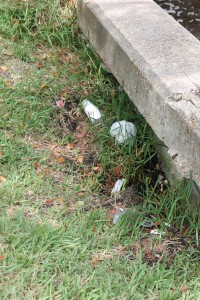
This small pile was the extent of trash found at the seawall on May 15. According to Paul Harden, attorney for the neighbors adjoining the right-of-way, the Surfaces and the Cousars have picked up “beer cans by the thousands” from this area.
Brooks Moore, an attorney who has lived on Richmond Street for 15 years, met, along with other concerned neighbors, with the adjacent neighbors to discuss their intentions. “They say it’s because it’s dirty,” she said. “The solution is not to deprive the neighborhood. Trash can be managed with trash cans.” Moore also noted that the bill was vague and that she didn’t understand why the review should be waived. Moore’s husband Chip and 17-year-old daughter Woody both spoke against the bill at the May 26 hearing.
“Access to the river here has been a big part of my childhood,” said Woody. “It’s been functioning as a park as long as I’ve been alive.”
Chip Moore asked that the process be slowed down to get public input and look at other options. “There are other solutions that can be explored,” he said. “It is one of the reasons we bought a house where we did.”
Over on Hedrick Street, Lude Stokes said, “Why would someone who doesn’t live in our district even propose this? I cannot understand why the city is trying to withdraw access.” Stokes, who has lived in the area for more than 50 years, said the access should be maintained and left open for all residents to enjoy.
Jim Polk, who lives on Pine Street had similar questions. “Why is this being done? Who is benefitting from this?” he asked. “I’d love to know. That river access does not need to be closed. I don’t want to believe that the city would sell us out like that, but nothing in Jacksonville surprises me anymore.”
Donna Lewis, also on Hedrick Street, was even more direct with Councilman Clark. In an email she said, “To my knowledge no effort was made to solicit input from the neighborhood in general or from those of us who live in the immediate area as to our thoughts on the matter. I find your involvement and the corresponding lack of community involvement to be a rather peculiar turn of events.”
Lewis also requested that his office send to her all supporting documentation, analysis, surveys, and property history, telling Clark in her email, “Any attempt to circumvent an existing ordinance is inherently suspect and warrants close public scrutiny and principled consideration.”
As of press time, Lewis had not yet received a reply to two requests for those documents. At the May 26 Council meeting, Lewis was one of more than two dozen who spoke against the bill, saying, “I want to deal in facts, not anecdotes or old claims of crime-ridden activity.”
Because the applicants, Surface and Cousar, have indicated safety concerns living on either side of the river access, Lewis has requested a Crime Prevention Through Environmental Design (CPTED) Survey from Gary Dickinson of the Jacksonville Sheriff’s Office Community Affairs Division, “to determine how we can, as a community, use landscape and other measures to deter criminal activities on the right-of-way.”
Make it a park
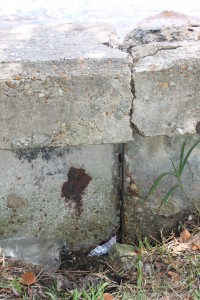
A hole in the bulkhead compromises the integrity of the bulkhead for the adjacent properties, fear the property owners.
Those speaking in favor of closing river access included a half dozen or so residents, as well as Harden, Surface and Cousar, citing reasons of safety. “My clients requested for two decades that the city clean it up,” said Harden. “This is not a park, public blogs notwithstanding.”
Harden stated that the JSO had suggested the surrounding homeowners find a remedy through closing the access, indicating that it had been identified as an unsafe location. There is not a clear line of sight from the street down to the river and often parked vehicles obscure sight of the trail head.
Despite the pleas to close it, the overwhelming opinion is to turn it into an official park.
Since that strip of land is not an official park, one of the solutions that RAP is looking at is to have the 60-foot wide by 437-foot long river access designated a park and brought under the Parks, Recreation and Community Services Department for oversight and maintenance.
If the city cannot maintain it, several nearby residents, including Bryan and Kim Clontz, have indicated a willingness to be part of a community-led park support group. The Clontzes started a GoFundMe account to collect funds to pay for monthly mowing.
“It should not just be the burden of the adjacent neighbors,” said Bryan Clontz. “It’s not that complicated [to maintain it].”
Tom and Sue Kenaston and Krystie Wells, in an email to The Resident, described the access as a “pocket park,” saying “[We] quite understood restricting parking along Edgewood Avenue near that pocket park to discourage the mess of dead fish, discarded fishing line, old bait and random fish hooks that the less respectful fishermen left behind but do not understand the lack of city maintenance or the city’s willingness to discard the pocket park at Little Van Wert as a public access park for the St Johns River. If it were periodically maintained and there were some enforcement of hours, public access wouldn’t be a concern.”
The solutions proposed seem to be “either/or” – either close the access to the public, giving the land to the Surfaces and the Cousars, or create a public park, allowing anyone to use it. No one, however, has yet suggested a King Solomon-like “cut the baby in half” compromise: enclose the City-owned property with chain link fencing and a padlock, thus ensuring that no one except authorized personnel have river access.
By Kate A. Hallock
Editor
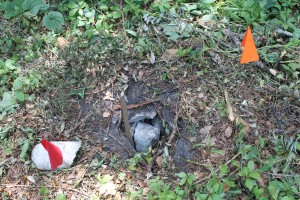
The right-of-way covers a storm drain that runs under the street out to the river. A portion of the drain appears to have caved in.




 (1 votes, average: 5.00 out of 5)
(1 votes, average: 5.00 out of 5)


